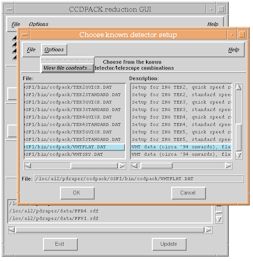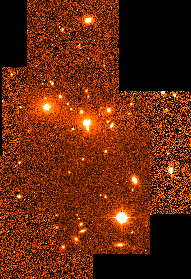CCDPACK
CCD data reduction
CCDPACK is a package of programs for reducing images taken by CCD-like
detectors.
Users of CCDPACK see the package as:
- A complete set of basic tools that can be controlled from the command line
or from scripts.
- An easy to use X windows interface for controlling automated reductions.
The X windows interface is designed to help those with little, or no,
knowledge of the package or CCD reduction, to start working effectively as
quickly as possible. It concentrates on the organisation and categorisation of
data, rather than the ins and outs of how and when to run the individual
programs, any necessary processing steps are deduced and executed automatically.
The more basic command-line programs cover:
- Bias estimation and removal.
- Dark counts and pre-flash correction.
- Flatfield calibration and correction.
- Image registration.
- Image resampling.
- Image combination and normalization.
Supporting facilities are also provided for controlling such things as the
automation of stages 1, 2 and 3.
All the basic CCDPACK programs are designed for processing large quantities
of data and consequently process whole lists of images and record their progress
using a integral logging system. They also allow: defect information to be
stored very concisely as text descriptions, the generation and subsequent
propagation of data errors and can use many different image combination methods
(mean, median etc.).
The registration of many images with different scale factors and orientations
can be performed at once. More commonly if the images have the same scale and
orientation, but have different origins, then they can be registered either
"automatically" or graphically with a minimum of effort.

The main window of the CCDPACK GUI. Note that the "Help" menu has
been pulled down. "On Context" tells you how to get help on any part
of the window. "On Window" describes this window in overview. "On
CCDPACK" access the main CCDPACK document.

Another snapshot of the CCDPACK GUI. This window allows the selection of a
known CCD camera. If the images where taken on the WHT after 1994, then they can
be reduced automatically. All that is necessary is to identify the data files
(this is done in a separate window).

If the CCD used isn't already known to CCDPACK, then it is necessary to
supply some information about it. The most important parameters are the extents
of the light-sensitive area and the bias strips. If these are not known, then
help is at hand -- in this window the image can be panned and zoomed and any of
the required regions identified by dragging the mouse over them.

This picture shows the result of "automatically" aligning eight
images that have different origins. The marked stars have been detected and
identified across all the images "automatically". The registering
transformations derived from the knowledge of which star is which on each frame
have then been used to resample the images so that they are aligned. The images
have then been combined into a single "mosaic". The mosaic is not
"flat" because of exposure and sky brightness variations.

This picture is the same data as shown before, except that it has now been
"normalized", correcting for any changes in exposure and sky
brightness (any visible variations are now due to noise changes due to the
different number and quality of images present at each point).
CCDPACK is documented in the "Starlink User Note No. 139". This is
available on the WWW at:
http://www.starlink.ac.uk/star/docs/sun139.htx/sun139.html.
Hardcopy can also be obtained from this document.
|